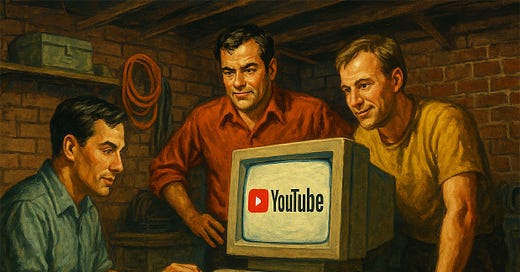History of YouTube: Founded By 3 Guys in San Mateo
Three young men in San Mateo had a simple idea to solve a video sharing problem. Years later they were bought by Google and the rest is history!
YouTube is one of those platforms that feels like it’s always been there—kind of like Google or smartphones. But believe it or not, the world’s largest video-sharing site started in a humble garage (well, sort of) with a simple idea: What if sharing videos online was as easy as uploading a photo?
How Was YouTube Founded?
Let’s rewind to 2005. Back then, the internet was a different place. Social media wasn’t what it is today, and uploading large video files was a slow and clunky process. Three former PayPal employees—Steve Chen, Chad Hurley, and Jawed Karim—wanted to change that. The story goes that they were frustrated they couldn’t easily share videos from a dinner party, and that inspired them to build something better.
So, on February 14, 2005, YouTube was officially founded in San Mateo, California. A few months later, in April, Jawed Karim uploaded the very first video titled “Me at the Zoo.” It’s just 18 seconds long and features him standing in front of elephants at the San Diego Zoo, talking about trunks.
It’s not exactly viral content by today’s standards, but it marked the start of something massive.
Keep It Simple, Stupid!
What made YouTube stand out right away was simplicity. You didn’t need fancy software or technical skills. Just upload your video, and the site handled the rest. It quickly became the go-to place for everything from home videos and music performances to comedy skits and vlogs. By the summer of 2006, YouTube was already drawing in over 100 million video views per day, and more than 65,000 videos were being uploaded daily.
Naturally, that kind of explosive growth attracted attention.
Google Buys YouTube
Enter Google. In November 2006, just over a year after YouTube launched, Google bought the company for a whopping $1.65 billion in stock. At the time, people scratched their heads—was a video-sharing site really worth that much? But as we now know, that bet turned out to be one of the smartest investments in tech history.
With Google’s backing, YouTube went from fast-growing startup to full-blown internet titan. Google integrated it with its powerful search engine, improved ad systems, and expanded its reach globally. Soon, YouTube became more than just a place to watch funny videos—it became a career platform. The rise of the YouTuber had begun.
YouTube Creators are Born
Creators like PewDiePie, Jenna Marbles, and Smosh built massive audiences, and YouTube rewarded them through the YouTube Partner Program, which allowed content creators to earn money through ad revenue. Brands like NordVPN found these YouTubers to be an effective new way to promote their online brands. This move turned hobbies into businesses and inspired millions of people to pick up a camera and start filming.
Over the years, YouTube has evolved in big ways. It introduced HD and 4K video, live streaming, YouTube Shorts, and YouTube Music. It’s also become a central hub for education, fitness, gaming, beauty, reviews, and just about every niche imaginable. Whether you want to learn how to fix your sink or follow your favorite musician on tour, YouTube probably has a video for it.
Challenging Copyright Issues
Of course, YouTube has faced its fair share of challenges too. It’s had to navigate copyright issues, content moderation, and controversies around misinformation. But through it all, the platform has adapted and grown stronger.
Today, YouTube has over 2.7 billion logged-in monthly users and is available in over 100 countries in more than 80 languages. It’s not just a website—it’s a cultural force that has changed the way we consume media, connect with others, and express ourselves.
Interesting Facts About YouTube:
YouTube is the second-most visited website in the world—right after Google, its parent company.
The first YouTube video ever uploaded was "Me at the Zoo" by co-founder Jawed Karim on April 23, 2005.
Over 500 hours of video are uploaded to YouTube every minute.
YouTube reaches more 18–34 year-olds in the U.S. than any cable TV network.
So how did YouTube become so successful? The answer is a mix of timing, simplicity, creator empowerment, and a powerful boost from Google. But maybe more than anything, it’s because YouTube gave the world something it didn’t have before: a voice.
And in a world where everyone wants to be heard—or at least seen—YouTube hit the sweet spot.





